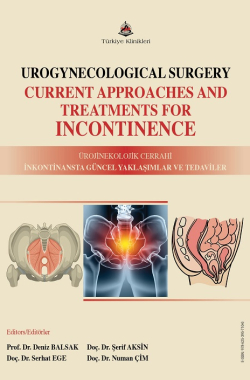BLADDER NECK SUSPENSION
Ceren Sağlam
İzmir City Hospital, Department of Gynecology and Obstetrics, İzmir, Türkiye
Sağlam C. Bladder Neck Suspension. In: Balsak D, Çim N, Ege S editors. Urogynecological Surgery Current Approaches and Treatments for Incontinence. 1st ed. Ankara: Türkiye Klinikleri; 2025. p.191-196.
ABSTRACT
Bladder neck suspension surgery constitutes one of the cornerstone treatment modalities for female stress urinary incontinence (SUI), particularly in women with urethral hypermobility and preserved intrinsic sphincter function. The primary objective of these procedures is to re-establish anatomical stability of the bladder neck and proximal urethra, enabling appropriate urethral compression during episodes of increased intra-abdominal pressure and thereby preventing urinary leakage. Historically, the Marshall-Marchetti-Krantz (MMK) procedure, introduced in the mid-20th century, represented the most widely performed technique. This method provides support by anchoring the bladder neck to the periosteum of the symphysis pubis, yet it is associated with complications such as osteitis pubis and long-term voiding dysfunction. As an alternative, the Burch colposuspension was developed, in which paravaginal tissues are fixed to Cooper’s ligament, offering lower bone-related morbidity while maintaining comparable continence outcomes.
The introduction of minimally invasive approaches during the 1990s marked a significant advance in surgical management of SUI. Laparoscopic bladder neck suspension, performed either via transperitoneal or extraperitoneal access, follows the principles of Burch colposuspension but benefits from smaller incisions, reduced blood loss, shorter hospital stay, and more rapid postoperative recovery. Reported shortand mid-term cure rates of laparoscopic procedures are comparable to those of open techniques, with studies indicating success rates of 80–90% in selected patients. However, the efficacy of these operations is highly dependent on careful patient selection and the surgeon’s proficiency in laparoscopic pelvic anatomy.
Despite favorable outcomes, complications remain a clinical concern. Intraoperative risks include bladder and urethral injuries, bleeding, and damage to adjacent organs. Early postoperative problems may involve urinary retention, hematoma, or infection, while long-term complications include voiding dysfunction, recurrent SUI, de novo urgency, and pelvic organ prolapse. Success rates, although initially high, tend to decline over time, with MMK and Burch procedures demonstrating continence rates of approximately 70–75% at 10–15 years.
Future perspectives focus on enhancing outcomes and minimizing complications through the use of advanced biomaterials, improved suture techniques, robotic-assisted platforms, and patient-tailored surgical strategies. In this context, bladder neck suspension procedures are expected to remain integral in the treatment of SUI, especially in carefully selected patient groups, emphasizing the importance of individualized management and long-term follow-up.
Keywords: Urinary incontinence, stress; Laparoscopy; Urinary bladder; Minimally invasive surgical procedures; Urethra
Kaynak Göster
Referanslar
- Gaum L, Ricciotti NA, Fair WR. Endoscopic Bladder Neck Suspension for Stress Urinary Incontinence. Journal of Urology. 1984;132(6):1119-1121. [Crossref] [PubMed]
- Bladder neck needle suspension for urinary incontinence in women. In: Cochrane Database of Systematic Reviews. John Wiley & Sons, Ltd; 2002.
- Mainprize TC, Drutz HP. The Marshall-Marchetti-Krantz Procedure: A Critical Review. Obstetrical & Gynecological Survey. 1988;43(12):724-729. [Crossref] [PubMed]
- Hegarty PK, Power PC, O'Brien MF, Bredin HC. Longevity of the Marshall-Marchetti-Krantz procedure. Ann Chir Gynaecol. 2001;90(4):286-289.
- Castro-Diaz DM, Padilla-Fernandez B. Which procedure for stress urinary incontinence? Colposuspension. Current Opinion in Urology. 2020;30(2):279-280. [Crossref] [PubMed]
- Kobashi KC, Albo ME, Dmochowski RR, et al. Surgical Treatment of Female Stress Urinary Incontinence: AUA/ SUFU Guideline. Journal of Urology. 2017;198(4):875-883. [Crossref] [PubMed]
- Papasakelariou C, Papasakelariou B. Laparoscopic bladder neck suspension. The Journal of the American Association of Gynecologic Laparoscopists. 1997;4(2):185-189. [Crossref] [PubMed]
- Kayigil O, Iftekhar Ahmed S, Metin A. The coexistence of intrinsic sphincter deficiency with type II stress incontinence. J Urol. 1999;162(4):1365-1366. [Crossref] [PubMed]
- Albala DM, Schuessler WW, Vancaillie TG. Laparoscopic bladder suspension for the treatment of stress incontinence. Semin Urol. 1992;10(4):222-226.
- Lee RA, Symmonds RE. Repeat Marshall-Marchetti procedure for recurrent stress urinary incontinence. American Journal of Obstetrics and Gynecology. 1975;122(2):219-229. [Crossref] [PubMed]
- McDuffie RW, Litin RB, Blundon KE. Urethrovesical suspension (Marshall-Marchetti-Krantz). The American Journal of Surgery. 1981;141(2):297-298. [Crossref] [PubMed]
- Yang JM, Yang SH, Huang WC. A surgical technique to adjust bladder neck suspension in laparoscopic Burch colposuspension. Journal of Minimally Invasive Gynecology. 2006;13(4):289-295. [Crossref] [PubMed]
- Yang SC, Park DS, Lee JM, Graham RW. Laparoscopic extraperitoneal bladder neck suspension (LEBNS) for stress urinary incontinence. J Korean Med Sci. 1995;10(6):426. [Crossref] [PubMed] [PMC]
- McDougall EM, Heidorn CA, Portis AJ, Klutke CG. Laparoscopic bladder neck suspension fails the test of time. Journal of Urology. 1999;162(6):2078-2081. [Crossref] [PubMed]
- Kobak W. Determinants of voiding after three types of incontinence surgery: a multivariable analysis. Obstetrics & Gynecology. 2001;97(1):86-91. [Crossref] [PubMed]
- Clemens JQ, Stern JA, Bushman WA, Schaeffer AJ. Longterm results of the Stamey bladder neck suspension: direct comparison with the Marshall-Marchetti-Krantz procedure. J Urol. 1998;160(2):372-376. [Crossref] [PubMed]
- Palma PCR, Soffiatti SAWD, Almeida SC, Pinotti JA. Stress Urinary Incontinence: A Comparative Study of Surgical Treatment by the Marshall-Marchetti-Krantz Technique with Endoscopic Suspension of the Bladder Neck. Second Report. Asia-Oceania Journal of Obstetrics and Gynaecology. 1988;14(1):31-36. [Crossref] [PubMed]
- Forneret E, Leach GE. Cost-effective treatment of female stress urinary incontinence: Modified pereyra bladder neck suspension. Urology. 1985;25(4):365-367. [Crossref] [PubMed]
- Tan N, Sri D, Tsang D, et al. Robotic-assisted laparoscopic colposuspension for female stress urinary incontinence: a prospective series. J Robotic Surg. Published online April 6, 2022. [Crossref]
- Yuanzhuo C, Liao P, Chi Z, Shuai X, Deyi L. Efficacy and Safety of Robot-assisted AUS Implantation Surgery in Treating Severe Stress Urinary Incontinence: A Systematic Review and Meta-Analysis. Urology. 2023;171:88-95. [Crossref] [PubMed]
- Subotic S, Rassweiler J. Experimental Evaluation of Suture Support in Bladder-Neck Suspension for the Treatment of Female Stress Urinary Incontinence. Journal of Endourology. 2007;21(8):931-938. [Crossref] [PubMed]
- De Oliveira Freitas DM, Comin VM, Rodrigues E. 360-Degree Running Suture Technique in Robotic-Assisted Surgery for Bladder Neck Contracture. CRSLS. 2025;11(4):e2024.00041. [Crossref] [PubMed] [PMC]
- Bruskewitz RC, Nielsen KT, Graversen PH, Saville WD, Gasser TC. Bladder Neck Suspension Material Investigated in a Rabbit Model. Journal of Urology. 1989;142(5):13611363. [Crossref] [PubMed]
- Gregorakis A, Bouropoulos C, Dimitriou D, et al. Delayed reaction to the Dacron buttress used in Stamey bladder neck suspension. Int Urol Nephrol. 2006;38(2):269-272. [Crossref] [PubMed]

